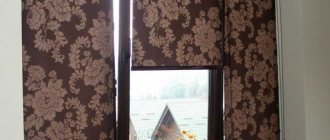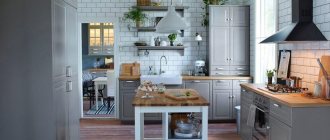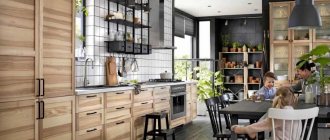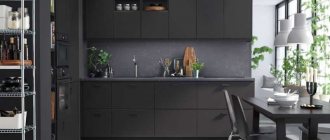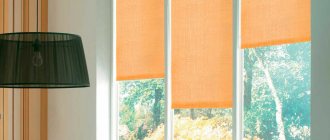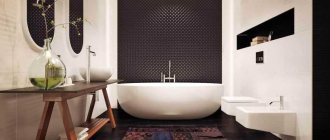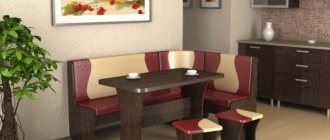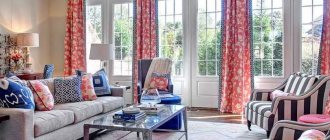What are photo aprons made of?
Many materials are suitable as a basis for production. The main requirements for raw materials are:
- Resistance to detergents and cleaning agents;
- Fire safety;
- Impact resistant, insensitive to small scratches.
Thus, MDF (improved quality chipboard), HDF (high-density fibreboard), plastic panels of various modifications and degrees of density (PVC, PMMA, polycarbonate), glass (skinali) are most often used.
Let's find out how to choose an apron with photo printing, based on the characteristics of the material from which it is made.
Polymer panels
They are the most popular for making both textured and photo aprons due to their affordable price and fairly good wear resistance. They are made from smooth PVC or slightly rough, but more durable polycarbonate or plexiglass.
Regarding PVC, this material is moisture resistant, has average heat resistance (it can deform near an open fire), is lightweight and can be easily washed using surfactant products.
Panels made of plexiglass and polycarbonate are more expensive, but much stronger and can withstand quite serious heat. Scratches and minor defects are not so visible on them.
What is better to choose
Kitchen skins from the manufacturer have proven quality, are made by professionals, and are made from different materials:
- Glass products are in greatest demand, they are environmentally friendly, attractive in appearance, impact-resistant, durable, but they are more expensive than other models and do not have absolute heat resistance;
- Stalinite is considered a durable material, can withstand heat, and is easy to clean. Glass is tempered at temperatures above 600 degrees, which increases its strength and reliability;
- Triplex is considered the most wear-resistant material for skins. It is made by gluing together several layers of glass. To enhance individual characteristics, reinforcing film, pattern or silvering can be used;
- Cheap materials include polycarbonate, plexiglass, and ABS plastic. Low cost causes low performance, susceptibility to mechanical damage, and erasing of the design.
Disadvantages of PVC and PMMA aprons
This product requires special attention during operation. To avoid deformation of the segments under the influence of high temperature, you need to use a cover in the area of the stove or additionally cover the panel with glass.
In addition, they should not be washed with abrasive or acid-containing compounds, or use cleaning nets or other rough devices. If there is a need for washing, you need to use microfiber cloths.
Practicality and availability of plastic
One of the most affordable and “amenable” to photo printing materials is plastic. Such an apron, firstly, will perform the main function of protecting the walls, and, secondly, it will be relatively inexpensive.
Printing on plastic is applied directly - this decoration option is more reliable. The picture will retain its color for a long time. Of course, you can reduce the cost of the product and choose a model with photo printing in the form of a polymer film. But there is a risk of getting the design deformed over time. What are the benefits of such plastic aprons?
- They have high moisture resistance. Under the influence of steam, the picture will not fade, and the material itself will retain its properties. The following photos show aprons that are made of plastic and decorated with colorful pictures.
- They are easy to care for. Since the panel is installed in the working part of the kitchen in one continuous piece, there will be no problem such as cleaning the seams. Plastic panels are easy to keep clean - they can be rubbed with a sponge or detergents and the pattern will not lose color.
- Plastic models are lightweight. You can install them yourself. To do this, you don’t need to achieve perfect smoothness of the walls and stock up on a dozen tools. By the way, if you get tired of photo printing, you can replace the kitchen apron and decorate the work area with a new product.
In the following photos you can see what plastic aprons look like in kitchen interiors.
This design technique has been particularly popular lately: printing a pattern on the apron is repeated with the decor of the tabletop or upholstery of chairs in the dining area.
Let's look at the shortcomings. A plastic product may become deformed, especially if the panel is located above the stove area. Also, over time, color printing can fade and become scratched. Why? If you use chemical powders and aggressive cleaning agents, the plastic will lose its beauty.
Glass
Most often, you can see a photo of a printed kitchen apron made of tempered glass. Skinals can have either a glossy or subdued matte surface.
Note!
U-shaped kitchen: pros and cons of the U-shaped layout. Methods of arranging furniture, dividing into working and dining areas. Photos and videos of design ideas- Kitchen facades: TOP 180 photos and video reviews of kitchen facades. Types of frames, criteria for choosing materials and color solutions
- Short curtains for the kitchen - features of using short curtains in small and large kitchens. Advantages and disadvantages of fabric materials (photo + video)
The design can be under glass (in the case of using photo wallpaper), on its surface as a moisture-resistant self-adhesive, or directly on the glass panel.
The last option is the most expensive because it gives a spectacular three-dimensional image. Together with the photo solution, decoration of the skin by sandblasting can be used.
Mounting methods
To fix the apron to the wall, you will have to choose between “liquid nails” or special fasteners usually used for installing mirrors. The option with liquid nails is better because it eliminates gaps and joints. As a result, the coating is better protected.
Hinged and through fasteners are also used, but have a number of significant disadvantages.
- Firstly, they are not hidden from the eyes of visitors to the kitchen.
- Secondly, there remains a space between the wall and the apron, which will fill with condensation and dirt over time.
- In addition, the presence of play reduces the strength of the glass, and such a surface is easier to damage or break.
Let's summarize: the main purpose of a kitchen apron is to protect the wall from dirt that is inevitable during the cooking process. And models made of glass meet the necessary requirements for this decorative element. The choice of product must be made based on the type of material, method of applying the pattern, design and price.
A properly selected apron helps compensate for the lack of space and light, making the room functional and comfortable.
Advantages of glass aprons
- High degree of fire safety;
- Possibility of using various cleaning methods;
- Increased wear resistance.
Among the disadvantages of glass aprons, one can note the high cost and complexity of installation.
You can often see fairly cheap specimens; their main difference is the lack of hardening. Such skins can be quite fragile and are “afraid” of scratches.
Chipboard-based materials
Considering the average price category of kitchen splashbacks, we can note MDF panels. This is the same material from which most furniture is made, so it fits perfectly into the interior.
Note!
Water filter for the kitchen: functions and benefits of a water filter in the kitchen. Types of filters and mechanisms, their pros and cons (photo + video)- Kitchen in high-tech style: 135 photos and video master class on organizing space and design
- Kitchen in modern style - 160 photos of the best design options and features of the style
Since MDF is based on wood, the panels should not be exposed to moisture or high temperatures.
The design is applied to them either by means of moisture-resistant self-adhesive, or by lamination or application of acrylic film.
Advantages of interior design
What attracts buyers in this material and what distinctive qualities set it apart from other decor:
- Durability. The average service life of some types is 15-20 years or more;
- An attractive appearance that can completely transform a room, add an accent, additional lighting due to a mirror surface or LED lighting;
- Durability, reliability. Glass and plastic panels protect walls from dirt and are not subject to mechanical shock;
- Fire resistance. High-quality materials withstand high temperatures well and can be mounted near the stove
- One-piece fabric without seams or bulges reliably protects against moisture, splashes and drips;
- The kitchen skins catalog offers a huge selection of ready-made images and materials for production that will fit perfectly into any interior. You can make a custom apron;
- Easy to care for, can be wet cleaned;
- Expand design possibilities, make each room unique;
- You can buy skinals for the kitchen at sales offices, order them in construction stores, or choose the model you like on the Internet.
The disadvantages of the panels include:
- High cost;
- Painstaking preparatory work requires precise measurements and complex installation. If the hole was made incorrectly at the factory, correcting it in the future will be problematic;
- The need to cut out the whole canvas with all the notches.
Select a pattern
At the moment, the variability in creating images for photo aprons is simply amazing.
In most cases, the design is applied to ordinary vinyl paper, as when creating waterproof wallpaper. Pictures for photo printing on an apron can be found on the Internet or when ordering from a catalog from the manufacturer.
Depending on the method of applying the image, the price will vary, and the monetary issue is directly affected by the degree of protection of that same design.
The higher the degree of wear resistance of the coating, the more expensive the design will be.
How strong and durable is the pattern on the panel?
The image on a kitchen skinali can be very diverse and is applied using different techniques. That is why a wide range of products is obtained, even when decorated with the same pattern.
You can achieve a unique interior using various techniques:
- Use of stencil blanks. At the production stage, paint is applied by conveyor method to the glass surface;
- The varnish coating gives the product a matte finish and additional strength. Translucent varnish is applied from the back and has a rich color palette;
- Lakobel gives the apron a varied shade;
- Mirror surfaces can visually expand the kitchen space and change the geometry of the room. They can use both individual elements interspersed in the overall background, and fully reflective surfaces with relief lines, smooth or with patterns;
- Glass surfaces lend themselves well to sand processing, engraving, and hand painting. Such equipment will cost more, but will pay off with its uniqueness and presentability;
- The possibility of simply gluing a polymer film on the back of the panel makes the skins inexpensive and accessible to the masses. A more durable and reliable option is to use a film with a pattern between the layers in the manufacture of triplex. This application is not subject to abrasion, is durable, and does not fade. In this way, it is possible to create 3D paintings that can completely transform the kitchen and become a central accent;
- The use of the latest technologies has made it possible to create canvases using photo printing, which makes it possible to transfer any photographs onto glass and create three-dimensional images.
Successful design solutions
On average, a kitchen apron lasts 5-7 years, so when choosing an image you should take into account that this picture will “please” the eye for quite a long time.
Therefore, you should not choose too bright or expressive images. It is advisable to choose a color scheme that matches the wallpaper or typeface.
If the furniture is made “like wood” or with accents on other natural materials (marble), you need to adhere to the same motives in the design of the apron.
For discreet interiors, you can use plain options.
A photo apron is an excellent solution for decorating a work area in the kitchen, however, before ordering such a product you need to think carefully about all the details, take into account all the pros and cons of each material and choose the most suitable design.
The beauty of this product largely depends on the quality of installation, on how accurately the holes for sockets and other communications are cut (if they are needed on the working wall), so measurements and installation should be entrusted to representatives of the manufacturer.
Catalog of skins for the kitchen
The modern market for finishing materials offers a huge variety of options with which you can decorate or decorate a room.
Paint, plaster, many types of wallpaper, polymer films, panels, plastic, MDF walls, stickers, thousands of tile options - the range is colorful and varied. This or that material has both pros and cons, however, against the backdrop of this diversity, glass is an alternative option that combines the advantages of all materials. A modern kitchen apron is made of glass, on which a design is applied with UV printing and a background is created, so such products will decorate a kitchen made in any style. The glass for the panel is processed in a special automatic furnace, where it is heated to a high temperature and then cooled sharply. Glass that has been in the oven will be decorated with a design; the ink is applied from the side adjacent to the wall, which means there is no possibility of damaging the design. Such glass wall protection is:
- environmentally friendly, since the glass is tempered, the ink is environmentally friendly, - stable and durable, since the thickness of the glass is from 6 to 19 millimeters, withstands impacts from blunt and heavy objects, and is not afraid of chemical exposure. - heat-resistant, since the glass is tempered in furnaces, which allows it to withstand temperatures up to 240 degrees, and the printed image up to 130 degrees. - durable, if there are no violations of the operating rules, such a panel can last for decades, and replacement will only be required at the request of the owner, to change the style. - hygienic, since glass has the properties of repelling fat, and therefore there is no proliferation of microbes in the kitchen, surprising with the cleanliness of the surface. - practical, because a glass apron for the kitchen does not require special cleaning and care products; simple detergents are suitable for cleaning. - safe, because the strength of the glass is several times higher than usual, and if the panel does break, its fragments have a fairly large diameter and blunt ends, which will prevent injuries and cuts. - aesthetic and exclusive, since glass printing can recreate any image, panorama, painting and images, just select it in the manufacturer’s catalog, or offer your own version.
By choosing a skinali - a modern solution for a kitchen apron, you will be convinced of all the advantages, and besides, your guests will envy you, because no one else will have such a kitchen but you. Another important advantage is that such an apron is quick to install, which means it will not take much time to install. The pricing policy for these products is adequate, so choosing a glass apron for your kitchen is the best option. A glass apron in the kitchen is a skillful solution to emerging difficulties in the kitchen. This is a way to express your style and imagination. More and more consumers are choosing skins to decorate their work panels. After all, this is an indicator that the owner is a modern, tasteful person who strives to decorate his life and make it as safe and useful as possible.
Our image catalog contains unique wide-format images for the skin in high resolution. Any of these designs can be printed on your future kitchen apron. All images are sorted by motive: flowers, animals, fruits, drinks, cities, waterfalls, etc. In each category, additional sorting by dominant color is available.
Each image is assigned an alphanumeric code in which the first letter or word is the first letter or word of the category name. Just click the “Order” button on the image you like and enter your details. The price of the future product does not depend on the chosen pattern; the cost is calculated relative to the price per square meter. The catalog of images of kitchen skins contains thousands of pictures for different types of kitchens - classic, modern, high-tech, modern, rustic or country. You are highly likely to find something here that you really like. If you have your own ideas, we are always ready to implement them. High resolution photographs are accepted for printing. You can order and buy glass splashbacks in Moscow and the Moscow region by placing an order on the website or by contacting our specialists by calling +7 (926) 1491839, +7 (926) 6777861.

